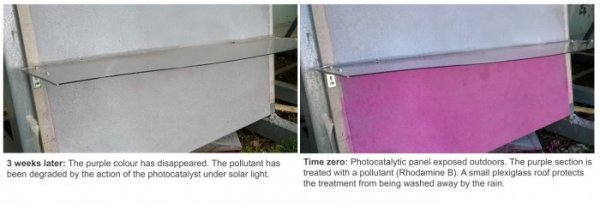According to foreign media reports, a group of engineers combined graphene and titanium dioxide nanoparticles to make a new type of solar catalyst that can absorb pollutants in the air and is much more efficient than other catalysts. The catalyst can be applied to the surface of buildings or streets to improve the air quality of cities.

Although carbon dioxide often makes headlines in air pollution, it is far from the only compound that causes air pollution. Nitrogen oxides and volatile organic compounds emitted through automobile exhaust and industrial processes cause smog and damage human health.
In the past few years, researchers have conducted experiments using titanium dioxide nanoparticles (also known as titanium dioxide) to remove this air pollution. Titanium dioxide acts as a photocatalyst, which means that once activated by light, it will decompose pollutants. This has been used in air-purified concrete and aluminum building panels and water filters.
In past work, the surface of titanium dioxide has shown an efficiency of up to 45% for converting nitrogen oxides in the atmosphere into harmless nitrates. For new research, the team managed to increase this ratio to 70%. The secret ingredient is graphene.
The researchers used liquid-phase stripping technology to strip the graphene layer from the base material graphite, but made a new adjustment to this conventional process-they added titanium dioxide nanoparticles to the mixture. This enabled them to create a new graphene-titania nanocomposite.
This material can then be applied to surfaces such as streets, sidewalks, or building exterior walls to passively clean the air. It is completely powered by sunlight, so the nitrate produced is harmless.
The researchers said: "This photocatalytic cement matrix is ​​suitable for buildings, it can make the surface self-cleaning by reducing nitrogen oxides and air pollution-the so-called 'absorb the haze' effect. Graphene can help improve the catalyst of titanium dioxide and other catalyst Photocatalytic behavior and enhance the performance of cement. "
The team tested the mixture by manufacturing photocatalytic plates and exposing them to contaminants. In one test, they used rhodamine B (which has a molecular structure similar to volatile organic pollutants. After testing in water and activating by ultraviolet light, the research team found that graphene-titanium dioxide composite material is better than titanium dioxide catalyst alone The degradation of rhodamine B is 40% more.
In the next test, the researchers found that graphene and titanium dioxide catalysts can degrade nitrogen oxides by more than 70%. "The combination of graphene and titanium dioxide provides excellent results-it can be applied to different materials, of which concrete is a good example of widespread use and helps us achieve a healthier environment," Marco, who participated in this study Goisis said: "It is low-maintenance and environmentally friendly, because it only needs the energy of the sun and no other investment."
Although these early results are promising, the team said that more work needs to be done before commercializing the technology. First, graphene is still tricky in mass production, but many scientists are already studying this issue.
This work was carried out by scientists from Graphene Flagship, University of Bologna, Polytechnic University of Milan, CNR, NEST, Italcementi HeidelbergCement Group, Israel Institute of Technology, Eindhoven University of Technology and Cambridge University.
The research was published in the journal Nanoscale.
Uv Light For Air Purification,Air Uv Lamp,Ultravation Uv Light,Germguardian Uv Light Replacement
Guangdong Kingrate Optoelectronic Technology Co., Ltd. , https://www.kingrateuv.com